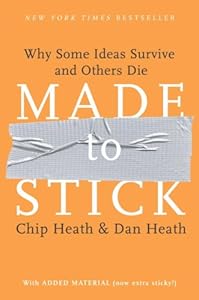The right story makes you act
In Made to Stick, the Heath brothers describe six principles that make your idea sticky - that make it easy for people to remember and tell others about. Those six principles (and the effects they have) are:
- Simple ideas help you remember.
- Unexpected ideas make you pay attention.
- Concrete ideas help you understand.
- Credible ideas make you believe.
- Emotional ideas make you care.
- The right story makes you act.
Stories demonstrate how you can act - what steps you can take, what obstacles you might face, how to overcome them, and what results you might expect. In The Elements of Persuasion, Richard Maxwell and Robert Dickman talk about the role of the Hero - the character who embodies your message, and demonstrates "how to live your story".
A well-told story gives your audience enough information so they can mentally test how they would handle the situation. This mental rehearsal is the next best thing to actually doing something. As the Heath brothers say, stories are like flight simulators for the brain.
I've talked about the Curse of Knowledge before. It's the natural tendency for people who are passionate experts in a subject to forget what it's like to know nothing about that subject, to forget that their audience are non-experts. Passionate experts will explain things to their audience in lots of detail, using industry buzzwords and jargon, and leaping from point to point while assuming that their non-expert audience will either naturally follow what's being said, or that it's too boring to bother explaining.
Made to Stick describes the Curse of Knowledge as the number one enemy of creating a sticky message. Your audience won't spread your message if you bore them, or if they don't understand, or if they don't care.
The Heath brothers believe that stories can almost single-handedly defeat the Curse of Knowledge. Stories almost always describe things in everyday, easy-to-relate-to images and actions (they're Concrete). Many stories have Emotional or Unexpected elements to them (these make us care and pay attention).
Stories transform knowledge and statistics into something that's relevant, something we can imagine happening in our lives.
Stories defeat our natural inclination to reduce our message to a series of bullet points.
- Unlike a story, bullet points give us nothing to mentally simulate; there's nothing for us to become engaged in.
- Bullet points are just knowledge. Dry, abstract.
- Bullet points usually convey common sense - that makes them easy to ignore.
This public servant's presentation consisted of pages of bullet-points, and him reading what the bullet points said. Perhaps it was my hunger, or my increasing irritation at being read to, or even that I didn't feel that his spoken words were adding any value to what I was reading ... I don't know what it was, but I gradually stopped paying even the pretence of attention, and just started writing up notes for a new webseries idea on my notepad.
As a result, I can remember that the presentation was given, but I can't remember anything about it.
Except, of course, for a story (that for confidentiality reasons I won't go into specifics about) about how the leaders of a certain organisation manuevred their way out of having to do their annual reports. Which was pretty cool, actually.
Keep your eye out for good stories
So, the idea is to wrap a story around your message. That'll make it easier for people to remember and pass on. The Heath brothers emphasise that we don't need to spend a lot of creativity on making up stories. We just need to be ready to spot the good ones that life generates every day.
In other words, we need to know our message and constantly be on the lookout for stories and real-life events that epitomise and reinforce our message. A great example of this is Jared Fogle, the guy who lost weight eating subway sandwiches. His story is an effective way of delivering Subway's rather clinical message that they have six subs that have less that six grams of fat.
Drawing from an analysis of the Chicken Soup for the Soul series, the Heath brothers identify four 'story templates' that are useful to keep an eye out for:
1. The Challenge plot - where people overcome daunting obstacles. These stories inspire people to take on a challenge and work harder.
2. The Connection plot - where people develop a relationship that bridges a gap (racial, class, ethnic, etc). These stories encourage tolerance, co-operation, love.
3. The Creativity plot - where people come up with unconventional solutions to problems through lateral thinking, breakthroughs, puzzle solving, and being MacGuyver.
4. Springboard stories - these tell people about possibilities; they let people see how an existing problem might change. Springboard stories motivate people to act. They focus people on potential solutions and shift them in to problem-solving mode.
.gif)

![Reblog this post [with Zemanta]](http://img.zemanta.com/reblog_e.png?x-id=e8cb6f42-1965-4542-bb21-ebdcae007ba8)
No comments:
Post a Comment